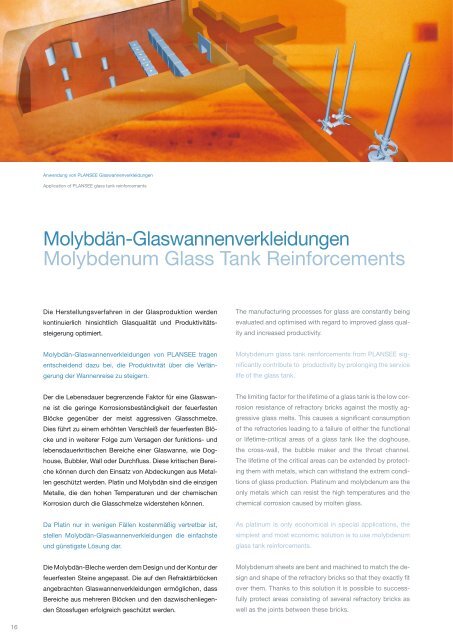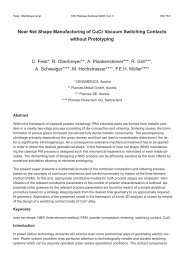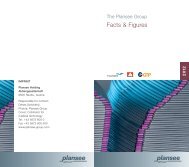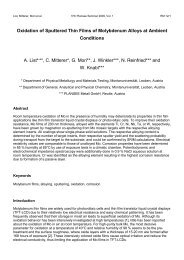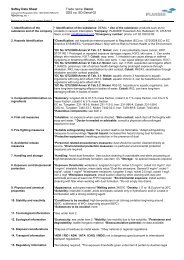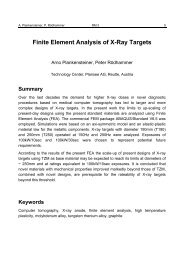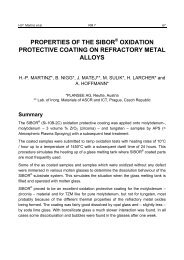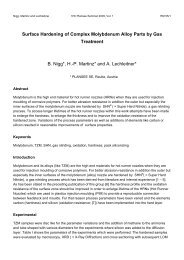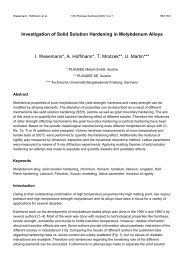Glastechnik Glass Technology - Plansee
Glastechnik Glass Technology - Plansee
Glastechnik Glass Technology - Plansee
Create successful ePaper yourself
Turn your PDF publications into a flip-book with our unique Google optimized e-Paper software.
16<br />
Anwendung von PLANSEE Glaswannenverkleidungen<br />
Application of PLANSEE glass tank reinforcements<br />
Molybdän-Glaswannenverkleidungen<br />
Molybdenum <strong>Glass</strong> Tank Reinforcements<br />
Die Herstellungsverfahren in der Glasproduktion werden<br />
kontinuierlich hinsichtlich Glasqualität und Produktivitätssteigerung<br />
optimiert.<br />
Molybdän-Glaswannenverkleidungen von PLANSEE tragen<br />
entscheidend dazu bei, die Produktivität über die Verlängerung<br />
der Wannenreise zu steigern.<br />
Der die Lebensdauer begrenzende Faktor für eine Glaswanne<br />
ist die geringe Korrosionsbeständigkeit der feuerfesten<br />
Blöcke gegenüber der meist aggressiven <strong>Glass</strong>chmelze.<br />
Dies führt zu einem erhöhten Verschleiß der feuerfesten Blöcke<br />
und in weiterer Folge zum Versagen der funktions- und<br />
lebensdauerkritischen Bereiche einer Glaswanne, wie Doghouse,<br />
Bubbler, Wall oder Durchfluss. Diese kritischen Bereiche<br />
können durch den Einsatz von Abdeckungen aus Metallen<br />
geschützt werden. Platin und Molybdän sind die einzigen<br />
Metalle, die den hohen Temperaturen und der chemischen<br />
Korrosion durch die <strong>Glass</strong>chmelze widerstehen können.<br />
Da Platin nur in wenigen Fällen kostenmäßig vertretbar ist,<br />
stellen Molybdän-Glaswannenverkleidungen die einfachste<br />
und günstigste Lösung dar.<br />
Die Molybdän-Bleche werden dem Design und der Kontur der<br />
feuerfesten Steine angepasst. Die auf den Refraktärblöcken<br />
angebrachten Glaswannenverkleidungen ermöglichen, dass<br />
Bereiche aus mehreren Blöcken und den dazwischenliegenden<br />
Stossfugen erfolgreich geschützt werden.<br />
The manufacturing processes for glass are constantly being<br />
evaluated and optimised with regard to improved glass quality<br />
and increased productivity.<br />
Molybdenum glass tank reinforcements from PLANSEE significantly<br />
contribute to productivity by prolonging the service<br />
life of the glass tank.<br />
The limiting factor for the lifetime of a glass tank is the low cor-<br />
rosion resistance of refractory bricks against the mostly aggressive<br />
glass melts. This causes a significant consumption<br />
of the refractories leading to a failure of either the functional<br />
or lifetime-critical areas of a glass tank like the doghouse,<br />
the cross-wall, the bubble maker and the throat channel.<br />
The lifetime of the critical areas can be extended by protecting<br />
them with metals, which can withstand the extrem conditions<br />
of glass production. Platinum and molybdenum are the<br />
only metals which can resist the high temperatures and the<br />
chemical corrosion caused by molten glass.<br />
As platinum is only economical in special applications, the<br />
simplest and most economic solution is to use molybdenum<br />
glass tank reinforcements.<br />
Molybdenum sheets are bent and machined to match the design<br />
and shape of the refractory bricks so that they exactly fit<br />
over them. Thanks to this solution it is possible to successfully<br />
protect areas consisting of several refractory bricks as<br />
well as the joints between these bricks.


